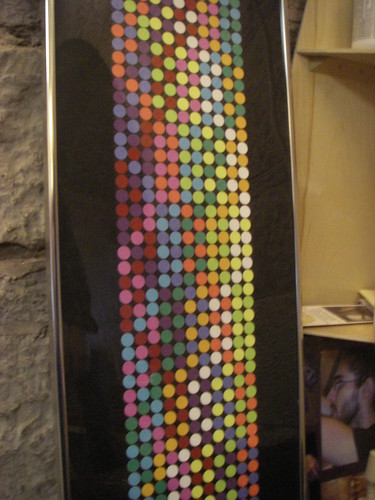Where I'd left off was "How do you play music on those things?"
The picture I'd posted at the end of yesterday's post? That's tower bell music. Doesn't look like any music you've ever seen, does it? Unless you're a change ringer who's stumbled across this, of course!
The fact is, despite the fact that even the smaller bells can outweigh their ringers by two or three times, and therefore completely impossible to stop in mid-swing - there is a moment, when the bell loses momentum at the top of its arc, that the physics of the situation change & for that moment, the ringer can influence the timing of when the bell begins to fall back in the other direction. The ringer can hold for a second, or move on a little more quickly, and by doing so they can switch places with a bell that's ringing next to them.
So let's say you start with 8 bells ringing consecutively in an ascending scale (called "rounds", can be fewer bells or more bells, depending on how many ringers you have & how many bells in the ring - Trinity has 12 & that's what you'll see in the video, if you make it to the video!):
1 is the highest, or treble; 8 is the lowest, or tenor -
1 2 3 4 5 6 7 8
1 2 3 4 5 6 7 8
1 2 3 4 5 6 7 8
Once everybody's got a nice steady flow going, then the ringers can use that moment of control to start switching the order. This is just an example I'm making up on the spot, but here the treble is going to switch spots with the #2 bell. If the ringers are good, the rhythm won't be disrupted at all, just the order of the notes. And this is pretty much how the notation I showed yesterday works -
Here we go, #1 & #2 switching spots-
1 2 3 4 5 6 7 8
2 1 3 4 5 6 7 8
And then 1 can switch with 3, and then 4, and so on (and I'm highlighting the 1 so you can see where it goes)
2 3 1 4 5 6 7 8
2 3 4 1 5 6 7 8
2 3 4 5 1 6 7 8
2 3 4 5 6 1 7 8
2 3 4 5 6 7 1 8
etc etc.
The 1 can also go back the other way, so you could have something like this;
2 3 1 4 5 6 7 8
2 3 4 1 5 6 7 8
2 3 4 5 1 6 7 8
2 3 4 1 5 6 7 8
2 3 4 5 1 6 7 8
2 3 4 1 5 6 7 8
2 3 1 4 5 6 7 8
2 1 3 4 5 6 7 8
And of course other bells can be switching with their neighbors as the same time as the 1 is weaving it's way through too, and that's when it turns from my made-up example to some real tower bell music:

That was on the back of the frame of this graphic-art piece, a gift to the tower from artist Helen Whitehead, a nice visual take on how the patterns of notes change:

And here's how it all comes together with 12 ringers on as many bells!
NOTE - This has sound! I'm not sure why (YouTube newbie, you know) but for some reason it starts with the YouTube volume control turned all the way down. Thanks O-Docker for the note!
Here's what's going. They begin with "rounds", descending scales with the 12 bells being rung in smallest to largest order, highest to lowest, aiming for a nice even rhythm. Changes start right around 1:30. The young man with the beard & the kelly-green shirt was the leader for this set. You'll hear him shout something (I can't quite make out what it is); on that cue, he & the 11 other ringers begin the changes in ringing order. They gradually switch spots with each other, weaving their way through the order. At 1:57, the leader shouts "Back round" - at that point, the ringing order has completely inverted itself & a moment later you will hear one ascending scale, lowest to highest. The weaving then begins again until right around 2:30, when you'll hear the leader shout "This is all!" and the basic descending round resumes until the next cue starts them off on another set of changes.
And there you have it!
Interested in finding out more? Check out http://www.nagcr.org/ - that's the website for the North American Guild of Change Ringers.
No comments:
Post a Comment